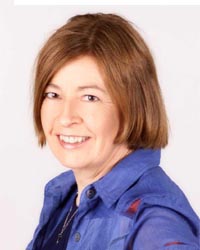
introducing readers to writers since 1995
May 24, 2005
Author2Author: Juliet Marillier & Jules Watson, pt. 1
by Ron HoganAuthor2Author veers into antipodean territory this week with Juliet Marillier and Jules Watson, both of whom live in the vicinity of Perth (although Juliet is actually a native New Zealander). Jules' first novel, The White Mare, was published in the U.S. a few months ago, and is the first installment of a three-part historical fantasy. Meanwhile, the opening book in Juliet's most recent trilogy, The Dark Mirror, which also combines historical and fantasy elements, will be released to American readers in August.
 Juliet Marillier: One of the aspects of The White Mare that I really loved was your creation of characters who manage to stay true to the social order of the time and place (first century Britain) and yet grow and develop and are real and likeable to a contemporary readership. In particular, the two protagonists, Rhiann and Eremon, are seen to go through various psychological changes in the book. Of course, I have a special interest in this series as my own newseries deals with the same part of the world and the same Pict/Gael struggle (although it's set a bit later, in the 6th century). Have you found it a challenge to create characters we can identify with and still make them believable in their own culture?
Juliet Marillier: One of the aspects of The White Mare that I really loved was your creation of characters who manage to stay true to the social order of the time and place (first century Britain) and yet grow and develop and are real and likeable to a contemporary readership. In particular, the two protagonists, Rhiann and Eremon, are seen to go through various psychological changes in the book. Of course, I have a special interest in this series as my own newseries deals with the same part of the world and the same Pict/Gael struggle (although it's set a bit later, in the 6th century). Have you found it a challenge to create characters we can identify with and still make them believable in their own culture?
Jules Watson: It's always going to be a challenge as an historical author to set your characters firmly in their time while making them available to modern readers. I always start from the premise that people are pretty much the same all over, whether from different cultures or different time periods. I think we are all driven by the same emotions; we all react out of fear and insecurity, we all want safety and love. So I treat my characters as if they are modern in that sense, driven by the same things we are. I think it helps readers feel connected to them. Secondly, from what we know of the Celts, the complexity of their religious and social ideas is not reflected, for example, in a corresponding sophistication of their material surroundings. What we are mostly left with is the remains of their houses, and we think that because they were one-roomed, and not organised by and large like Roman towns, with heating and plumbing, that the Celts themselves were simple. Yet they sunk their efforts into creating amazing portable objects and art instead, and all the textiles and home furnishings and decoration they probably had have long since rotted away. So I've taken them back to that complex place, and treated them as every bit as sophisticated in thought, behavior, and ideas as we are.
Regarding your point about characters, I find that heroines are often drawn in books in a similar way. I decided I wanted to tell a deeply emotional, spiritual story against a historical backdrop, and I wasn't afraid to allow Rhiann to be "faulty". Perhaps she is an unusual priestess because she doesn't have all the answers: She has a public aura of being untouchable and in control, but really she is traumatised and unsure. I wanted to delve into some of the themes about how to keep one's heart open to love of others and self after suffering trauma. To do that, I needed her to be quite closed off and twisted with hurt and anger inside. A strange place to start a story, a strange idea for a heroine. But that is what came to me, and it actually gave me a great opportunity to develop her then, as she opens up.
As far as Eremon goes, to make him believable I decided to show his sensitivity only in relation to his role as warrior, noble, and leader. To his own culture he is the typical "hero," and yet I also showed only to my readers the cost of that position to him--the overwhelming responsibility, the conflict between personal goals and what is good for his men, the way the buck stops with him, so he has no one to relieve him of that burden, etc. This makes him immediately more complex. And as will be seen with the second book, The Dawn Stag, those roles of Rhiann and Eremon are turned on their heads, so I suppose I was playing around a lot with what is female and male power, and how the hero/heroine mix can work both ways.
your PayPal donation
can contribute towards its ongoing publication.